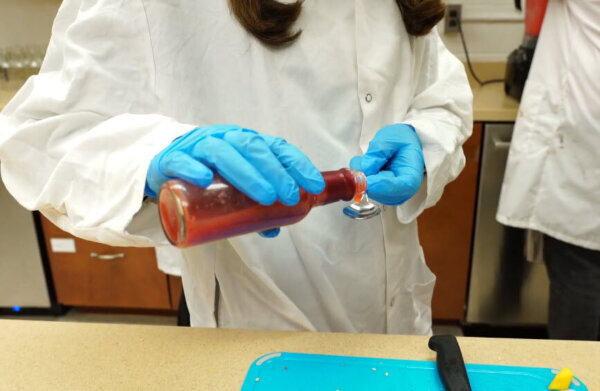Things will be heating up this Super Bowl Sunday, and not just in Arizona, where the game’s being played — instead, with chili and chicken wings in the super snacking lineup, many of us will be reaching for the hot sauce.
“I’ll start sweating, I’ll turn red, I’ll get the hiccups — that’s my indication that the hot sauce is good,” said professor Sean O’Keefe, of Virginia Tech’s College of Agriculture and Life Sciences’ Department of Food Science and Technology.
The science behind hot sauce, and our body’s reaction to it, starts with the peppers — and more specifically capsaicin — the colorless, odorless compound found in peppers.
Peppers range from sweet or mild to superhots, based on the Scoville Scale — the standard measurement system used to determine a pepper’s spiciness. Well-known Tabasco is considered medium-hot, while ghost pepper, Red Savina habanero, and Carolina Reaper are considered hottest of the hot.

After bites of food doused with hot sauces with names like Spontaneous Combustion, Colon Cleaner and Delicious Suffering, some of us will fan our mouths to try cool things down.
Here’s the thing — you’re not really hot, despite the fact you’re sweating. The peppers in the hot sauce are faking you out.
“Capsacin is the main chemical in these peppers that gives us the sensation of heat — it binds to a receptor in our mouth, and other parts of our body, that are normally tasked with determining if they’re exposed to a hot surface,” O’Keefe said. “So your body’s sort of tricked into thinking that it’s heat, when in fact, it’s not.”
Some people have always taken take pride in their ability to endure extremely hot sauce. “There’s TikTok people saying ‘I’m eating a ghost pepper, I’m eating this, I’m eating that,'” said O’Keefe.
O’Keefe, who says he eats hot sauce with almost every meal, doesn’t think the boasting is necessarily fueled by machismo.
“I had a friend in college, she was from Sri Lanka, and she brought in food that we’d share, that was very spicy,” he recalled. “She’d tell me, ‘be careful, this is spicy.'”
This Sunday, some of us will realize we’ve turned up the hot sauce heat too high: “Anything that has fat in it is going to remove them from the receptors in your mouth — whole milk is going to help.”
On the other hand, “if you drink cold water, it’s not going to help, because it doesn’t dissolve it off your receptors.”
Ah, so there’s a reason chili is often accompanied by sour cream, and wings are paired with blue cheese.
“Exactly right,” O’Keefe said. “Sour cream has much more fat than milk, so it’s should be more effective.”
With years of eating hot sauce, O’Keefe said he’s noticed he’s now able to tolerate much hotter varieties than he has in the past — he thinks he may have burned out his receptors.
“I think there is a bit of a habituation, where maybe your receptors throw in the towel and say, ‘we’re done with this, we’re not playing this game anymore, but I’m not sure there’s any research that shows that.”








